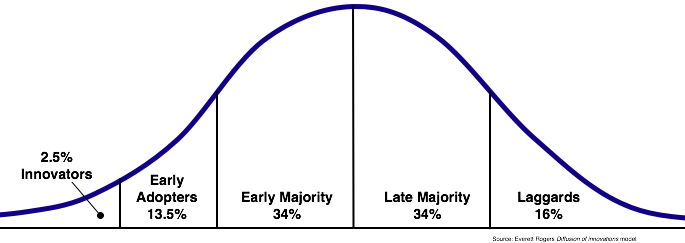Portable Stimulus and the Prius Model of New Technology Adoption
Tesla and the New Technology Adoption Curve
Over the past few years, I’ve noted with interest the increasing number of Tesla cars on the road. In many ways, the adoption of Tesla cars perfectly illustrates the standard technology-adoption curve that many of us who work with leading-edge technology have become familiar with. Back in the late 90s and early 2000s, pure-electric vehicles were truly a curiosity and used only by the most die-hard of innovators. In the intervening years, pure-electric vehicles have gradually become more and more accepted to the point that today they’re simply considered a nice luxury car. In terms of the new technology adoption curve, I think it’s safe to say that pure-electric vehicles have achieved a solid foothold in the Early Majority. And they’ve taken about 20 years to do so.
Prius: Smaller Potential Value, but Approachable
Contrast the adoption profile of pure-electric vehicles with that of hybrid vehicles like the Prius. Hybrid vehicles take advantage of some technology from pure-electric vehicles to improve the efficiency of existing gasoline-powered vehicles. They’re certainly not as exciting as pure-electric vehicles, and certainly don’t have some of the fun performance characteristics that pure-electric vehicles do. But, hybrids are incredibly easy to adopt because, from a user perspective, they’re just an incremental efficiency improvement on a well-understood and well-adopted existing technology. Hybrid vehicles took off about a decade ago, and today it’s quite unremarkable to see one on the road – in fact, I rarely notice anymore because they’re so common.
Back to EDA
So, what does this have to do with Portable Stimulus? Just like pure-electric vehicles, the new Portable Stimulus standard has some ambitious goals and has shown impressive results with early adopters. Portable stimulus aims to provide portable verification across verification platforms, reuse across levels of verification, and to support an “intent-driven” way of thinking about verification. Just as adopting a pure-electric vehicle involves a significant shift when moving from a gas-powered vehicle, adopting portable stimulus full-scale involves a significant shift for engineers who are writing SystemVerilog UVM tests and directed SoC tests today.
If history is any guide, adoption of full-scale PSS will likely follow the standard new-technology adoption curve. Just like the Prius took electric vehicle technology to improve efficiency, though, there are aspects of Portable Stimulus that can be adopted much more easily to improve the efficiency of existing UVM testbench environments. The intent-driven approach to test creation that PSS enables applies very nicely to the challenge of achieving coverage closure that we all face, and can be used with existing UVM testbenches with a trivial amount of changes. Learn more about adopting Portable Stimulus technology the easy way in your UVM testbench in my article Creating Tests the PSS Way in SystemVerilog in the most-recent issue of Verification Horizons!




Comments